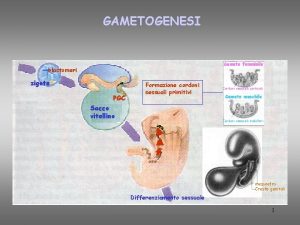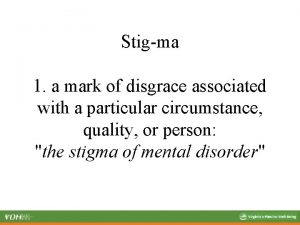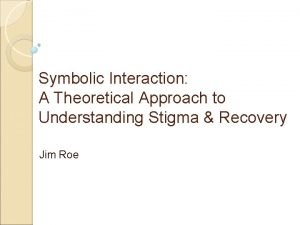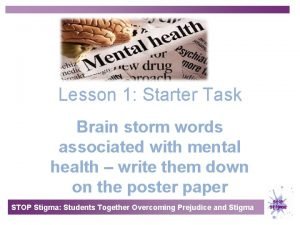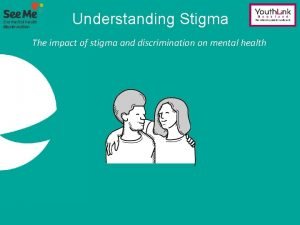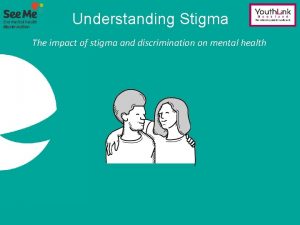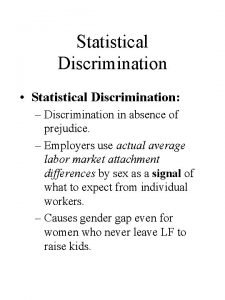Module 10 Treatment quality stigma discrimination Module 10


![Hepatitis C: status and blame [Regarding stigma] “…research on the mode of transmission has Hepatitis C: status and blame [Regarding stigma] “…research on the mode of transmission has](https://slidetodoc.com/presentation_image_h/18b7e870f53ea9f6731626fd31a6fe66/image-3.jpg)












- Slides: 15

Module 10: Treatment quality, stigma & discrimination

Module 10: Treatment quality, stigma & discrimination Module goal To develop participants’ capacity to provide or advocate for inclusive, high quality services that are accessible to people affected by HCV who currently or formerly inject Learning objectives By the end of the module, participants will be able to: § Distinguish a range of factors that can hinder or enable IDUs’ access to HCV testing and treatment § List cross-cutting ways in which different populations’ needs require special consideration § Summarise key sources of guidance that relate to HCV treatment for drug users Topics covered § Hepatitis C and stigma § Obstacles to the provision of HCV treatment and care § Good practice in integrated services § Obstacles to the uptake of HCV treatment and care § Guidelines on HCV treatment for drug users 1
![Hepatitis C status and blame Regarding stigma research on the mode of transmission has Hepatitis C: status and blame [Regarding stigma] “…research on the mode of transmission has](https://slidetodoc.com/presentation_image_h/18b7e870f53ea9f6731626fd31a6fe66/image-3.jpg)
Hepatitis C: status and blame [Regarding stigma] “…research on the mode of transmission has shown that contraction through intravenous drug use is most stigmatised. Hepatitis C, while perceived as having secondary status to HIV (Treloar and Rhodes, 2009), is more closely associated with intravenous drug use because this is by far the most common route to its contraction in the developed world (Butt et al. , 2007), unlike HIV. There is therefore an assumption that people with hepatitis C are – or have been – intravenous drug users, with the attendant blame for acquiring the disease and putting other people at risk of infection. ” Lloyd C (2010) Sinning and Sinned Against: The Stigmatisation of Problem Drug Users. London: The UK Drug Policy Commission 2

Hepatitis C: experiences of stigma and discrimination “Well, you could come and visit, but where are you going to use the washroom? ” (The grandmother of a woman with chronic HCV) Butt, G. , Paterson, B. L. and Mc. Guinness, L. K. (2007). Living with the stigma of hepatitis C. Western Journal of Nursing Research, 30 (2), 204– 21. “Most people who have been diagnosed with hepatitis C face some form of stigma or prejudice in their daily lives. It could be hearing a phrase like “you people, ” or a slight pause when you divulge your HCV status. Friends may stop calling, employers and coworkers may act differently, or it could be as subtle as a facial expression. In any event, we all know how it feels to be treated differently based on our being HCV. ” Franciscus A (2009) Hepatitis C: Support Group Manual. San Francisco: Hepatitis C Support Project. (www. hcvadvocate. org) 3

Cross-cutting factors § Prison incarceration § HIV co-infection § Gender § Ethnicity § Age (too young, too old) § Disability § Sexuality § Non-opiate users e. g. primary amphetamine or cocaine users § Mental health problems 4

Obstacles to the provision of testing and treatment 1 § Limited political commitment to HCV § HCV more poorly understood that HIV § Disease progression can take decades (except co-infection with HCV § Failure rate of treatment is a deterrent § Knowledge of HCV treatment tends to be poorer than for HIV § Treatment and care providers poorly informed about HCV Hoover J. (2009) Shining a Light on a Hidden Epidemic: Why and How Civil Society Advocates Can Support the Expansion of Hepatitis C Treatment in Eastern Europe and Central Asia. Access To Essential Medicines Initiative. New York: Open Society Institute 5

Obstacles to the provision of testing and treatment 2 § Access to medicines § Intellectual Property Rights § Refers to copyright, trademarks, and patents § Patents are most relevant to medicines § The World Trade Organisation’s agreement on Trade-Related Aspects of Intellectual Property Rights (TRIPS) provides the legal framework § Patents protected for 20 years § The costs of testing and treatment § Even in E. Europe/Central Asia standard 48 week treatment with ribavirin and pegylated interferon can cost $20, 000 6

Obstacles to the provision of testing and treatment 3 § State/police repression of IDUs and denial of access to the full range of services (health, legal, social) available to the general population § Limited access to primary health care, OST and antiretroviral therapy (ART) for people co-infected with HIV § Drug use, injecting and OST used as an exclusion criterion for HCV treatment § Lack of cooperation between drug treatment and infectious diseases specialists 7

Good practice example Health care delivery to drug users: program of comprehensive care “PCC-Prague”, in Prague, the Czech Republic § All services are concentrated within the premises of a single primary health care centre that is also attended by non-drug users. This helps to prevent segregation and stigmatization of patients. § Additionally, when other specialist services are needed, such as outpatient surgery, dentistry, gynaecology, etc. , they are available within the primary health care centre. 8

Obstacles to the uptake of testing and treatment § State/police repression of PWID § HCV advocacy lags behind HIV advocacy (lack of capacity in FSU) § Diagnosis not straightforward. Antibody test then PCR § HCV more clearly associated with injecting therefore testing may mean active or deductive disclosure of drug use § PWID poorly informed about HCV § Treatment side effects/toxicity may be assumed to outweigh benefits of treatment 9

Current guidance on HCV treatment for IDUs HCV/HIV co-infection: “Efforts must also be made, via multidisciplinary health-care services, to increase the applicability and availability of treatment, especially in more vulnerable populations, including but not limited to migrants, injecting drug users (IDUs), prisoners, people with psychiatric illnesses and people who consume too much alcohol. ” § Treatment of patients on opioid substitution therapy should not be deferred. § Initiation of HCV treatment in active drug users should be considered on a case- by-case basis. § Medical, psychological and social support from a multidisciplinary team should be provided for these patients. WHO (2007) HIV/AIDS TREATMENT AND CARE Clinical protocols for the WHO European Region 10

Current guidance on HCV treatment for IDUs (1) HCV/HIV co-infection: “Active drug use should not be an absolute exclusion criteria since full benefits of HBV and HCV therapy are not compromised when active drug users are successfully retained in treatment. Patients who require treatment should be offered opiate substitution therapy, including heroin maintenance programmes, where medically available. If the patient is not ready to stop drug use, any assessment for initiation of HBV or HCV treatment should be made on a case-by-case basis (AIII). ” 11

Current guidance on HCV treatment for IDUs (2) “Substitution therapy as a step towards cessation should be considered. Help provided (e. g. through needle- and syringeexchange programmes) reduces the risk of further reinfection, including parenteral viral transmission. (AIII). ” Short Statement of the First European Consensus Conference on the Treatment of Chronic Hepatitis B and C in HIV Co-Infected Patients, March 2005 Endorsed by the European Association for the Study of the Liver (EASL), the European AIDS Clinical Society (EACS), the European Society of Clinical Microbiology and Infectious Diseases (ESCMID), the European Federation of Internal Medicine (EFIM), the International AIDS Society (IAS), the French Society of Infectious Diseases (SPILF) and the European AIDS Treatment Group (EATG). New EASL Clinical Practice Guidelines for “Management of Hepatitis C Virus Infection” are in development 12

Current guidance on HCV treatment for IDUs (3) 59. Treatment of HCV infection can be considered for persons even if they currently use illicit drugs or who are on a methadone maintenance program, provided they wish to take HCV treatment and are able and willing to maintain close monitoring and practice contraception (Class IIa, Level C) 60. Persons who use illicit drugs should receive continued support from drug abuse and psychiatric counselling services as an important adjunct to treatment of HCV infection (Class IIa, Level C). American Association for the Study Liver Diseases (AASLD) Practice Guidelines (2009) Diagnosis, Management, and Treatment of Hepatitis C: An Update 13

Summary learning points § Experience varies but HCV status and being a PWID can each be a cause of stigma and discrimination § Beyond stigma, there are many factors than can inhibit both the provision and uptake of HCV testing and treatment § Guidance is nevertheless clear that PWID should have access to testing and treatment for HCV § Neither active drug use or ongoing OST treatment are reasons to exclude people from treatment 14



